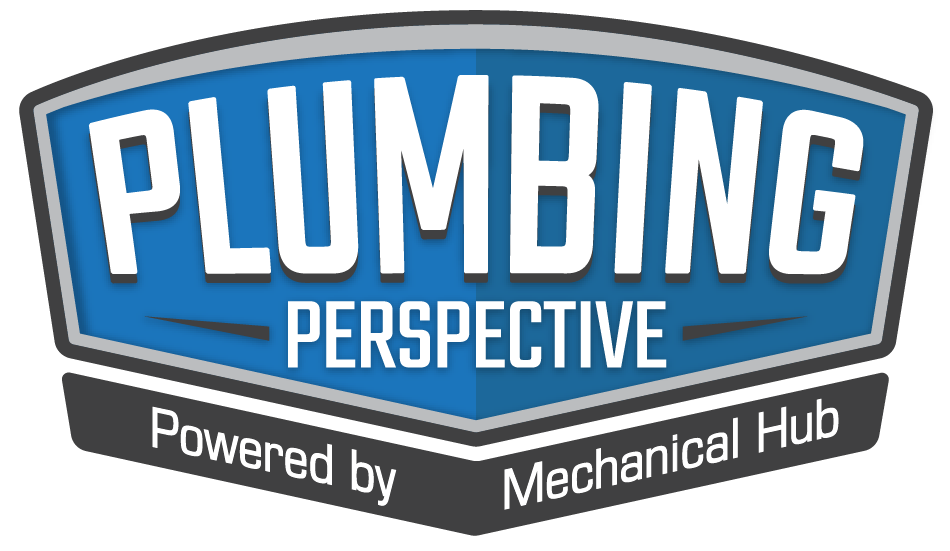The 2019 AHR Show in Atlanta is in the rearview mirror. Before I get into the meat of the show, I wanted to touch upon some of the “infrastructure” surrounding the show. First, most of the activities surrounding the Georgia World Congress Center are fairly concentrated, and that causes traffic problems at peak traffic times Read more
Industry Blogs

The 2019 AHR Show in Atlanta is in the rearview mirror. Before I get into the meat of the show, I wanted to touch upon some of the “infrastructure” surrounding the show. First, most of the activities surrounding the Georgia World Congress Center are fairly concentrated, and that causes traffic problems at peak traffic times. But I can’t express enough how with a great offering such as Uber and Lyft are, they weren’t a very efficient means of getting around, at least in this city. Most of the GPS coordinates were off, causing long waits or canceled trips. And, to my surprise, many drivers weren’t even familiar with the downtown area, as they were not even from around the area. Not all, but enough for me notice.

I stayed in an AIrBnb for the first time, and although the accommodations were nice, I was told by a driver that I was on the edge of the bad part of town. Not really something you want to hear upon arriving. I really hope everyone’s experience of the city was a good one. Just think, Atlanta sets the stage for one of the biggest events I n the world in a couple of weeks — the Super Bowl!
The AHR Show
The Expo drew more than 65,000 attendees, with 1,809 exhibitors total, 496 international exhibitors from 35 countries and 107 first time exhibitors. I thought the show itself was very good. Well organized, fairly easy to get to and from the two exhibits halls via a connector, once you knew where it was located. It seemed that a lot of the booths had girth, size, and were well presented and represented.

Taco’s John White, Jr. (l) presents the Taco Comfort Solutions 2019 Dan Holohan Lifetime Contribution to Comfort Award to Dan Foley.
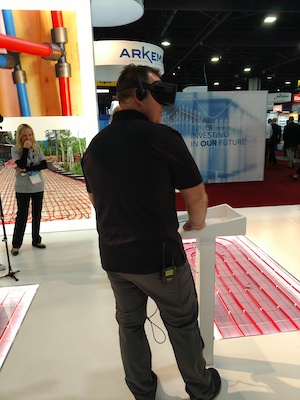
Eric Aune tests the VR experience in the REHAU booth at AHR.
The show opened up on Monday, and the Mechanical Hub crew was busy before the opening bell. Eric Aune and his wife Heather were getting the scoop, shooting video on Milwaukee Tool’s new M18 Threader. Look for more information and videos here and on our YouTube channels coming soon. Tim Ward was visiting with our friends at Uponor, learning more about its Copper Press Adapter. Finally, I was visiting with Taco, watching good friend Dan Foley receive the Taco Comfort Solutions 2019 Dan Holohan Lifetime Contribution to Comfort Award. Congrats, Dan!

John Mesenbrink checks out the VR experience in the Bosch Thermotechnology booth.
Some trends worth noticing was the ever-emphasis on energy efficiency, lowering GHG emissions, virtual reality, and interconnected devices, combining Alexa with thermostats, for example, piggybacking off of the CES Show earlier this year, and some products at last year’s Builder’s Show.
Lochinvar had a big announcement, telling the media it has partnered with Danish company, EC Power, to offer a cogeneration system, which pulls waste heat into water storage tank. Using an internal combustion natural gas engine, Micro CHP (< 50 kW/hr), is designed to be an efficient and easy-to-install system intended for light commercial use. Using natural gas as a fuel, a commercial facility with a cogeneration system like the XRGI25 can produce both energy-efficient heat for domestic hot water and electricity to reduce energy consumption from external power sources.

Some pre- and post-show events were held at the nearby aquarium. #breakfastwithbelugas
Xylem Bell & Gossett introduced its new line of double suction centrifugal pumps designed specifically for HVAC systems. The Series e-HSC features advanced hydraulics for powerful performance and best-in-class efficiency, along with a compact design for easier installation and maintenance.
In the end, some would say that the best part of the AHR Show—other than being the largest HVAC event of the year—is connecting with industry peers and catching up with good friends. There were plenty of pre-show/after-show parties, including Taco, Rheem, Bell & Gossett, Emerson, Burnham/U.S. Boilers, Mestek, Weil-McLain and Viega. Thanks to all for their hospitality.

In the end, it’s all about the relationships. Tim Ward winds down after the show with the crew from Bradford White.
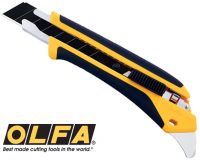
In partnership with our friends at OLFA, the Japanese maker of high quality utility knives and rotary cutters, we invite you to take advantage of a limited time offer of a free model LA-X 18mm Snap Blade Utility Knife. All you have to do to get your knife is CLICK HERE to enter your shipping Read more
In partnership with our friends at OLFA, the Japanese maker of high quality utility knives and rotary cutters, we invite you to take advantage of a limited time offer of a free model LA-X 18mm Snap Blade Utility Knife.
All you have to do to get your knife is CLICK HERE to enter your shipping information and you’ll be all set to receive your free knife loaded with OLFA’s ultra-sharp black snap-off blade.
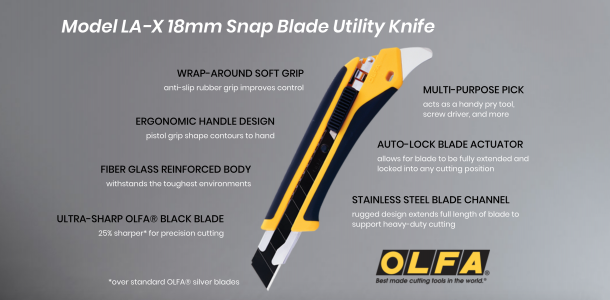

With more and more homeowners looking to smart technologies to automate their homes, people can now automate almost anything — lights, garage doors, windows, blinds, appliances, clocks, speakers, door bells, surveillance cameras, home security systems, climate control systems, cleaning systems, sprinkler systems, lawnmowers — even food preparation. So, what about their plumbing systems? If you Read more
With more and more homeowners looking to smart technologies to automate their homes, people can now automate almost anything — lights, garage doors, windows, blinds, appliances, clocks, speakers, door bells, surveillance cameras, home security systems, climate control systems, cleaning systems, sprinkler systems, lawnmowers — even food preparation.
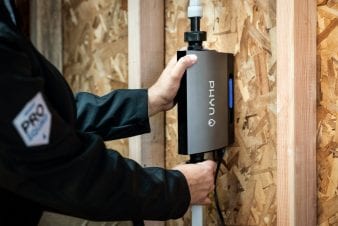
Phyn Plus installed with Pro Squad installer
So, what about their plumbing systems? If you think about it, homeowners would love to be connected to their plumbing systems. What if a pipe bursts when they’re away? Or, there’s a tiny leak that’s been quietly wasting water (and money) for months (think: toilet flappers, dripping faucets or pinhole leaks in corroded metal plumbing systems). For those that only get their water bill on a quarterly basis, that little leak could add up to quite a big cost over time (not to mention a tragic waste of water, our precious natural resource).
And, it doesn’t necessarily have to be a leak. There are those forgetful homeowners (or their children) who leave a faucet running and leave the house with the water going continuously. I’ve even heard of pets (typically cats) that accidentally turn on faucets and leave them running for hours until the homeowner returns to find little Fluffy has just wasted hundreds of dollars down the drain. Certain smart water detection systems can even alert homeowners of abnormal water events such as these.
Water leaks and water misuse are real, and every homeowner has experienced a water incident at one time or another. If you’re still not convinced, here are some interesting stats that might make you think differently.
- According to the Insurance Information Institute, water damage accounts for almost half of all property damage claims.
- About one in 50 insured homes has a property damage claim caused by water damage or freezing each year, and water damage ranks as the second most common home insurance claim.
- Of homeowners who have experienced a water leak claim in the past two years, 57% spent more than $5,000 on clean-up costs, and 15% spent $20,000 or more.
- 41% of homeowners say a device that alerts them to water leaks is highly
If you haven’t thought about it, now’s the time. Intelligent water is the next frontier in the connected home, and plumbers can benefit greatly from this new technology. Adding a smart water technology offering to your plumbing business is a great way to gain new business and offer a valuable new benefit to existing customers.
 How do you get started? First, you need to do your research. Certain manufacturers now offer smart water systems that are designed specifically with the professional plumber in mind. The Phyn Plus smart water assistant + shutoff, for example, is a connected plumbing device that is installed by a plumber in the Pro Squad nationwide network.
How do you get started? First, you need to do your research. Certain manufacturers now offer smart water systems that are designed specifically with the professional plumber in mind. The Phyn Plus smart water assistant + shutoff, for example, is a connected plumbing device that is installed by a plumber in the Pro Squad nationwide network.
It’s helpful if you’re familiar with the internet and have some tech savvy in your background. But, for products that are installed through a professional, exclusive network, you can get the training you need right from the manufacturer. All that’s required from you is a willingness to learn.
Think about it. Homeowners are craving new ways to get connected to the things in their homes, and they are willing to pay for it. They will pay you for it! Plus, when there is a leak detected in their home, guess who they’ll call?
These smart water technology systems are a wonderful revenue generator for anyone in the plumbing industry — from the established contractor to someone just breaking into the industry. They can apply to any type of application from new construction to remodels to re-pipes. Essentially anywhere there’s residential plumbing, these systems will work.
 And think about how great it would be to have your customers calling you straight from their connected device’s app whenever they need service due to a leak. It takes the guesswork out of the equation for homeowners regarding the best professional to call for the job, and it ensures a faithful client base for you. Win-win.
And think about how great it would be to have your customers calling you straight from their connected device’s app whenever they need service due to a leak. It takes the guesswork out of the equation for homeowners regarding the best professional to call for the job, and it ensures a faithful client base for you. Win-win.
So, if you’re ready to up the ante in your business to offer a smart water leak detection system, think about all the positives it can offer and how easy it can be to get trained and up and running on a technology that is going to be in demand in the very near future.
You could be one of the first in your area to offer it, opening doors to customers you might never have the opportunity to encounter otherwise.
 Kim Bliss is the content development manager at Uponor. She can be reached at kim.bliss@uponor.com.
Kim Bliss is the content development manager at Uponor. She can be reached at kim.bliss@uponor.com.

As they say in one of the world’s most popular television shows: winter is coming. With winter comes the inevitable rise in the number of burst pipe calls all plumbers will be tasked with repairing. Pipes are generally more likely to burst when the temperature drops below 20 degrees Fahrenheit. It is suggested that those Read more
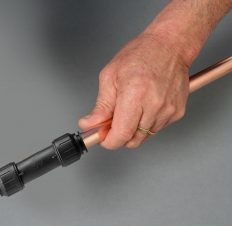 As they say in one of the world’s most popular television shows: winter is coming. With winter comes the inevitable rise in the number of burst pipe calls all plumbers will be tasked with repairing. Pipes are generally more likely to burst when the temperature drops below 20 degrees Fahrenheit. It is suggested that those living in cold-weather climates keep their homes heated to a minimum of 36 degrees if they are not going to be using their water for an extended period of time. However, no matter how present these warnings are, some winter pipe bursts are unavoidable.
As they say in one of the world’s most popular television shows: winter is coming. With winter comes the inevitable rise in the number of burst pipe calls all plumbers will be tasked with repairing. Pipes are generally more likely to burst when the temperature drops below 20 degrees Fahrenheit. It is suggested that those living in cold-weather climates keep their homes heated to a minimum of 36 degrees if they are not going to be using their water for an extended period of time. However, no matter how present these warnings are, some winter pipe bursts are unavoidable.
Fortunately, John Guest has committed time and effort to developing the products necessary to tackle this problem. The John Guest Speedfit slip connectors provide plumbers with a quick, simple, and easy fix for burst pipes.
 Their slip connectors come in two sizes and can be used to fix pipe bursts on PEX, CPVC, and copper pipes, providing an efficient solution to a litany of burst-pipe problems. John Guest slip connectors have push-fit connections, allowing for rapid installation that should at least temporarily solve one of the major issues with burst pipes: leakage. The push-fit fitting allows all of this to be accomplished without any additional pipe work.
Their slip connectors come in two sizes and can be used to fix pipe bursts on PEX, CPVC, and copper pipes, providing an efficient solution to a litany of burst-pipe problems. John Guest slip connectors have push-fit connections, allowing for rapid installation that should at least temporarily solve one of the major issues with burst pipes: leakage. The push-fit fitting allows all of this to be accomplished without any additional pipe work.
Slip connectors are also built to work with both hot and cold pipes, again providing coverage across the entire spectrum of possible burst-pipe issues that one may encounter. John Guest slip connectors are made with lead-free, non-toxic, and non-flammable materials so you can feel secure in installing these connectors for any issue and leave them to run without constant monitoring. Like all John Guest products, the Speedfit slip connectors are made with an advanced polymer material, assuring our customers that they are receiving only the highest-quality performance.
For more visit John Guest Speedfit slip connectors.
Des Plaines, Ill. — Geberit North America recently participated in the 2018 United Association (UA) Instructor Training Program, which ran from August 11 to 17, 2018 at Washtenaw Community College in Ann Arbor, Michigan. Geberit representatives provided instruction to attendees on the installation, maintenance and benefits of Geberit in-wall systems for wall-hung plumbing fixtures, showcasing Read more
Des Plaines, Ill. — Geberit North America recently participated in the 2018 United Association (UA) Instructor Training Program, which ran from August 11 to 17, 2018 at Washtenaw Community College in Ann Arbor, Michigan. Geberit representatives provided instruction to attendees on the installation, maintenance and benefits of Geberit in-wall systems for wall-hung plumbing fixtures, showcasing the versatility of Geberit products in modern plumbing applications, including ADA and universal design.
The UA Instructor Training Program is a 200- or 120-hour certificate program exclusively for instructors who are members of the United Association. The week-long program enhances scientific and technical knowledge and refines teaching techniques, equipping UA instructors to promote the achievement of students in an increasingly complex field. With over 200 faculty, industry representatives and manufacturers participating, and over 100 courses offered, the event provides the comprehensive education necessary to keep the plumbing and pipefitting industries on the cutting edge of twenty-first century advancements.

Ronn Jefferson teaching a course for UA instructors in Ann Arbor, Mich.
“The event in Ann Arbor was an incredible experience,” says Ronn Jefferson, product manager for Geberit North America. “Our audience was very enthusiastic about the introduction to Geberit products, especially the benefits provided in terms of maintenance, space savings, and accessibility. The effort and detail put into the program at every level demonstrates how committed the United Association is to promoting excellence in the industry.”
Participants noted the particular relevance of the introduction to Geberit products, with an increasing number of their projects prioritizing space savings for ADA and aging in place. They also applauded the built-in dual-flush capability provided by Geberit in-wall systems, a distinct advantage now that more and more people are seeking ways to save water.
“The United Association is securing the future of the industry by investing in quality education,” Jefferson adds. “Geberit North America is proud to play a small role in their efforts.”
